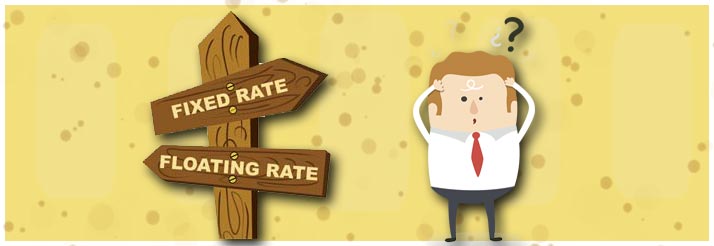When a borrower wants to take a loan, banks or NBFCs offer him or her two types of interest rates: fixed interest rate & floating interest rate. The borrower has to choose one of them to repay the loan. Once chosen, if the borrower wants to change from floating interest rate to fixed interest rate, banks and NBFCs do not charge any fees usually. But if shifting from fixed interest rate to floating interest rate, banks and NBFCs charge a penalty fees to the borrower.
Both types of interest rates have their respective advantages and disadvantages.
What is Fixed Interest Rate?
If the borrower chooses this type of interest rate, then the interest rate on the principal loan amount doesn’t change. The interest rate remains the same throughout the tenure and isn’t affected by the fluctuating market rates. People, who have a fixed monthly budget to pay for EMI, opt for this type of interest rate. With this interest rate, borrower can pay a fixed amount of EMI every month without any surprise fluctuation.
Advantages of Fixed Interest Rate:
- Fixed rate in fluctuating market conditions:
The borrower doesn’t have to be in worry of constantly changing interest rates in the market. Even if the interest rates go high, the borrower pays the fixed amount of EMI, unlike floating interest rates. The borrower can save an ample amount of money on this difference.
- A boon for those with a strict budget:
Many times the borrower who have taken a loan, have strict financial budget to pay EMIs and other monthly requirements. Such kind of borrowers can’t risk the market fluctuation. With fixed interest rate, the get a notion of security. They can plan their finances in the future as their EMI amount will be rigid due to fixed interest rate.
Disadvantages if Fixed Interest Rate:
- Higher interest rate amount:
In fixed interest rate, the borrower has to pay nearly 1% to 2.5% higher than the ongoing interest rate. This additional payment results as loss for the borrower. This exact interest rate amount is decided by the banks and NBFCs. And they change as per their policy.
- Zero benefits of decreasing interest rate:
If the interest rate decreases in the market, the borrower doesn’t get any advantages of that. The borrower has to pay the previously decided amount where as other borrowers who have opted for floating rate, enjoy paying much lower EMIs.
- It shifts to floating rate in longer tenure loans:
The fixed rate of interest automatically changes to floating interest rate in the loans with longer tenure (in home loan it changes after approximately 3 years). This is a policy decision take by banks and NBFCs and can’t be changed. So even the borrower wants to continue with fixed interest rate, he or she has to pay in floating rate after a certain period of time.
What is Floating Interest Rate?
If the borrower chooses this type of interest rate, then the interest rate on the principal loan amount changes as per the fluctuating interest rates in the market. The interest rate changes throughout the tenure. With this interest rate, borrower has to pay different amount of EMI every month with surprise fluctuations. The floating interest rates are linked to NBFC’s base rates and bank’s MCLR i.e. Marginal Cost of Lending Rate. These rates depend on Reserve Bank of India’s quarterly base rate announcements. If the borrower opts for this type of interest rate, he or she gets to pay lower amounts as compared to fixed interest rate.
Advantages of Floating Interest Rate:
- Benefits of decreasing interest rate:
When the interest rate in the market falls, the borrower enjoys a decrease in the EMI amount. The borrower can enjoy this benefit of decreasing market rate. Many times financial leaders predict increase and decreases in the future interest rate. So if the prediction is of decrease then the borrower should definitely opt for this type. The variety of interest rate helps the borrower to pay less.
- Cheaper than fixed interest rate:
Floating interest rates are cheaper compared to fixed interest rates as they change from time to time. As mentioned above, fixed interest rates are 1% to 2.5% higher in value of floating interest rate. So the borrower surely gets benefits of that difference.
- Saves funds:
If the market rate goes up, it surely decreases after a specific period and gives the borrower a chance to recover the loss in higher interest rate. So it basically helps the borrower to save more by helping to pay less.
Disadvantages of Floating Interest Rate:
- Unpredictable EMIs:
With floating interest rate, the amount of EMI depends on the market fluctuations and changes from month to month. So sometimes a borrower has to pay double or triple amount of EMI he or she paid a month before. This way borrower spends a lot of unnecessary funds every now and then. This EMI amount can’t be predicted by anyone as the market changes from time to time. This can shake the borrower’s financial planning every month.
- Not suitable for fixed income borrowers:
As mentioned above, the nature of EMI amounts remains unpredictable in floating interest rate. Thus it is not suitable for those with a fixed income and a fixed monthly budget. An increase in the market rate can lead for such borrowers to flush down more than half of their monthly income. This can send them in financial jeopardy. If they fail to pay their EMI due to this unpredictability, banks charge them with late a fee which is just another financial setback.
What to choose?
A borrower has to choose between a fixed interest rate and floating interest rate all by him/herself. If the market predictions in near future are of lower interest rate then many borrowers choose floating interest rate. But those who don’t want to take market risks opt for fixed interest rate. It’s decision to be made with cool mind and without any hurry.









